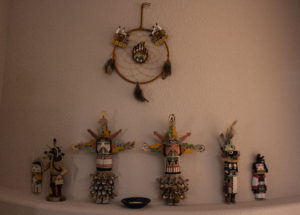![]() The nomad lifestyle has its appeal—never staying in one place too long to become attached. Non-attachment is the source of many spiritual and religious disciplines. Learn what you need to learn, do what you need to do and move on—hopefully with some acquired growth and knowledge. At some point, however, there’s a return to home—sometimes a home you’ve never been; at least not in this lifetime. That’s where I’m at, wondering how to best use this time—the final quarter.
The nomad lifestyle has its appeal—never staying in one place too long to become attached. Non-attachment is the source of many spiritual and religious disciplines. Learn what you need to learn, do what you need to do and move on—hopefully with some acquired growth and knowledge. At some point, however, there’s a return to home—sometimes a home you’ve never been; at least not in this lifetime. That’s where I’m at, wondering how to best use this time—the final quarter.
I’ve been drawn to Native American culture since childhood—growing up in New York City, I had my eye on the ground—mostly concrete and blacktop with the occasional grassy park where I found what I was sure to be “Indian Paths”. I spent countless hours at the Museum of Natural History seeking solitude amongst the dioramas and Native American village displays; progressing to the Amazon Rain Forest and the jungle sounds brought alive over speakers when a certain button was pushed. That’s what the east coast means for me—a place to leave for adventure—go west youngster. So, I did, as I had (I believe) in some previous life.
So, what. So, this. There is something happening on the Colorado Plateau, a desert region roughly centered at the Four Corners region of the southwestern United States. Of equal significance are the low deserts that extend to the Mexican border. Geographically, earth upheavals are apparent in every canyon, mesa, desert, and forest. Change has happened here, and it will again. No surprises, except that as the Hopi believe, this area, as it relates to our planet, is the center of the universe. Which is what draws me to the three Hopi mesas and their (almost) secret society of spirit guides.
A Kachina, or more appropriately, a Katsina is a doll of sorts, carved from the roots of the cottonwood tree. As I am in learning mode, I suggest for full explanations and better understanding that you read the many books and articles on the subject. My goal here is to show off (surprise!) what has come to me and is relevant in my home (as protection), my life and spiritual growth. I have so much more to share; most of which will have to wait for future blog posts.

Here is the gang (which came together from different carvers and sources) as they stand guard above the mantel. At the center are a male (Sa’lakwtaga) and female (Sa’lakwmana) pair of what were described to me as Monsoon deities. The feathers represent the rain and those can only be lightning protruding from their heads. Water, as for most peoples, is of paramount importance to the Hopi. The figures bring healing and cleansing to our home. To the viewer’s right is a young warrior with a snarky smile carved by a young carver, Brendon Kayquoptewa, who credits his father, Robert Kayquoptewa and older brother, Samuel as the early influences in his carving. I was drawn to this piece because of his youthful approach to life’s battles. On the left, the snake dancer, is not so much a spirit, but a participant in the Snake Clan’s ceremonial dances. I take snakes as my personal totem. I have maximum respect for their ability to strike, yet they prefer to avoid unnecessary confrontation. I also find them uniquely beautiful. Those of you afraid of snakes, probably wouldn’t like me much either.
Finally, on both ends are two cradle dolls carved by two different artists Paul Tso (simple style) and Myron Begoshwytewa (with braids). They are both Grandmother Katsina (Hahai-i wu-uti) or Happy Mother who shares with Crow Mother the title of Mother of all the Katsinam. Her husband is said to be Eototo and her children are the monsters, the Nataskas. She appears during the Bean Dance (Powamuya), the Serpent Ceremony and at Home Going (Niman). She speaks in a high voice and is very talkative. Flat carvings of the Grandmother Katsina are given to Hopi infants. As a young girl matures, she receives larger, more detailed forms of the Grandmother Katsina. I relate to these two as my soul in its infancy waiting to bloom.
ShareNOV
2019

About the Author:
Elaine Webster writes fiction, creative non-fiction, essays and poetry from her studio in Las Cruces, New Mexico—in the heart of the Land of Enchantment. “It’s easy to be creative surrounded by the beauty of Southern New Mexico. We have the best of everything—food, art, culture, music and sense of community.”